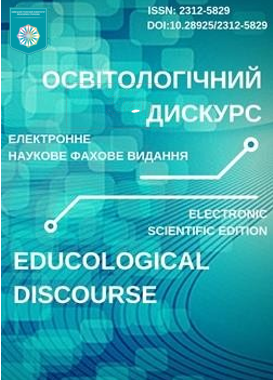Design Procedure of the Digital Educational Resources for Economic and Managerial Education of the Master’s in IT Students
DOI:
https://doi.org/10.28925/2312-5829.2024.13Keywords:
design procedure, digital educational resources, economic and managerial development, IT master’s studentsAbstract
Design and implementation of the digital educational resources into educational process enables acquiring of the practical experience by the students, that is crucial to their career in IT. It also brings modern technologies and innovative approaches to education. As a result, it improves involvement of the students and helps drive their academic results up. It is important to consider the fact that a master’s in IT may often occupy managerial roles in their future career. Understanding of the economic and managerial principles is crucial for effective and efficient leadership. It is reasonable to conclude that digital educational resources containing knowledge and practical experiences from these areas drive the integrated approach in professional development of the target audience. The design procedure for developing of digital educational resources for economic and managerial education of the master’s in IT students is important for the development of the qualitative professionals. The proposed design procedure consists of seven stages. Stage 1 includes pedagogical and technological aspects. Stage 2 is the problem definition. The problem to be solved by the development of digital educational resource, the goal and particular tasks are being defined on this stage. Stage 3 contains the task for the development of the digital education resource. Stage 4 incorporates detailed design of the content and external appearance of the digital educational resource. Stage 5 represents interactive development and testing. Interactive processes allow progressive improvements and adaptation of the resource. Stage 6 requires start of pilot implementation and assessment of effectiveness. Stage 7 allows implementation of the digital educational resource, its interactive update and modification according to the feedback and usage results. Each stage of the procedure requires completion of the previous stages. At the same time an interactive nature of the stages of the procedure enables constant progressive improvement, update of the content and approaches used in the resource. Detailed planning and completion of the stages is needed for the success of the procedure.
Downloads
References
Hrynko, V. (2021). Specificity of the model of designing digital educational technologies in future primary school teachers’ training. Professionalism of the Teacher: Theoretical and Methodological Aspects, 2(14), 78–89. https://doi.org/10.31865/2414-9292.14.2021.236875. (ukr.).
Hrynko, V. (2018). Designing digital educational resources by means of digital technologies. The origins of pedagogical excellence, 22, 58-62. https://doi.org/10.33989/2075-146x.2018.22.185010. (ukr.).
Krupko, S. (2022). Analysis of using of the electronic educational resources model in institutions of general secondary education. New learning technologies, 96, 112-9. http://journal.org.ua/index.php/ntn/article/view/326. (ukr.).
Benta, D., Bologa, G., Dzitac, & I. (2014). E-learning Platforms in Higher Education. Case Study. Procedia Computer Science : 2nd International Conference on Information Technology and Quantitative Management, ITQM 2014, 31, 1170 – 1176. (eng).
Damoense, Maylene Y. (2003). Online learning: Implications for effective learning for higher education in South Africa. Australian Journal of Educational Technology, 19(1), 25-45. (eng).
Sarah Guri-Rosenblit (2018). E-Teaching in Higher Education: An Essential Prerequisite for E-Learning. Journal new approaches in educational research, 7(2), 93–97. (eng).
Kevin, P. Brady, & Lori, B. (2010). Holcomb, and Bethany V. Smith. The Use of Alternative Social Networking Sites in Higher Educational Settings: A Case Study of the E-Learning Benefits of Ning in Education. Journal of Interactive Online Learning, 9(2). (eng).
Ravi, P. (2011). Bhatia. Features and Effectiveness of E-learning Tools. Global Journal of Business Management and Information Technology, 1(1), 1-7. (eng).
Arkorful, V., & Abaidoo, N. (2014). The role of e-learning, the advantages and disadvantages of its adoption in Higher Education. International Journal of Education and Research, 2(12), 397-410. (eng).
Jesús Valverde-Berrocoso, María del Carmen Garrido-Arroyo, Carmen Burgos-Videla & María Belén Morales-Cevallos (2020). Trends in Educational Research about e-Learning: A Systematic Literature Review (2009–2018). Sustainability, 12, 5153; doi:10.3390/su12125153. (eng).
Antoniuk, D. S., & Vakaliuk, T. A. (2021). Foreign experience of using digital educational resources in higher education. Pedagogy of forming a creative personality in higher and secondary schools: a collection of scientific papers: KPU, 2021. Issue 74. 216 с. VOL. 2. P.75-78. (ukr.).
Antoniuk, D. S. (2020). Theoretical and practical aspects of the development and use of digital educational resources: the view of domestic scientists. Bulletin of Zaporizhzhia National University: Collection of scientific works. Pedagogical sciences, 3, 189-196. (ukr.).
Published
How to Cite
Issue
Section
License
Copyright (c) 2024 Educological discourse

This work is licensed under a Creative Commons Attribution-NonCommercial 4.0 International License.
Автори зберігають за собою всі авторські права та одночасно надають журналу право першої публікації на умовах лізенції Creative Commons Attribution-NonCommercial-ShareAlike 3.0 Unported License, що дозволяє розповсюджувати даний матеріал із зазначенням авторства та первинної публікації в даному журналі.





















